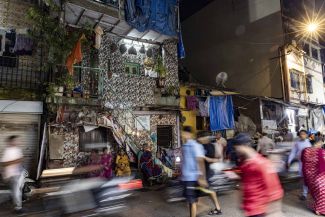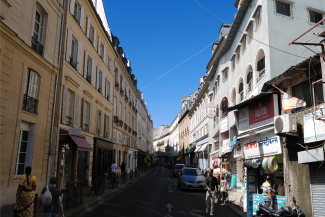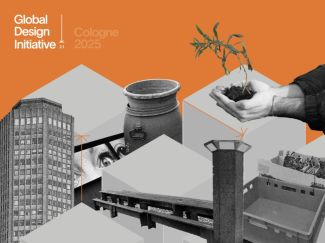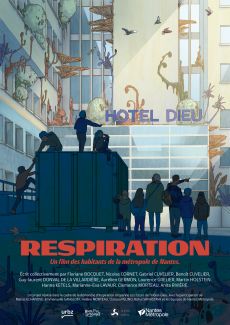Rahul Srivastava is a co-founder of urbz and The Institute of Urbanology. He studied social and urban anthropology in Mumbai, Delhi and Cambridge (UK). His previous publications include an ethnography of urbanized nomads around Mumbai, a novel published by Puffin, (Penguin, India) and 'The Slum Outside', a commentary on Dharavi, co-written with Matias Echanove and published by Strelka Press. He continues to write extensively on urban issues with Matias, with their next major publication signed up with Verso, London. He brings his background in anthropology and visual ethnography to urbanology, the practice that energises much of urbz's work in Mumbai and elsewhere.
Articles

Inlaks Shivdasani Foundation Interviews urbz co-founder Rahul Srivastava
Rahul Srivastava, was awarded the Inlaks Scholarship in 1993. He went on to co-found urbz and the Institute of Urbanology with Matias Echanove. This article features an interview with Rahul by the Inlaks Shivdasani Foundation as part of their Scholar Update series.

The Homegrown City book is (almost) out!
A new book by urbz co-founders, Matias Echanove and Rahul Srivastava, drawing on their learning from Mumbai, Tokyo and other cities where they have been active for over 15 years.

Fiction in Urban Practice
Fictional imaginaries help us move towards an important starting point in urban practice - 'recognition'. A way of seeing that transforms our understanding of urban spaces.

Visual Narratives for Participatory Urbanism: Documentation as Intervention
urbz has started initiatives in Europe, that combine ethnographic participation with visual storytelling to accompany, facilitate, or initiate urban planning, heritage, and transformation projects.

A Koliwada in Dharavi
This article presents the Koliwada in Dharavi through the evolution of its built and natural environment, tracing the Koli's fight for their land, how the community is leading the development of their neighbourhood and our role in it.

re:arc selects urbz!
Following up on the biggest news we had in our yearly update, we want to share more about how we got to kickstart our dream project in Dharavi Koliwada. Here we go.

2024 - Here we are !
We take a moment to reflect on urbz's achievements in 2023 and our objectives for 2024. We started in Mumbai in 2008 where we are busier than ever. Over the years we expanded our activities to Goa, Bogota, Geneva and now Paris. For 2024, we make the good resolution of communicating better and more frequently with our friends and followers!

John Turner - From Lima to Mumbai
Latin America and India share a common history of experimentation in slum-upgrading and incremental housing strategies. The ideas of John Turner, who was informed by years of work in Lima, in particular have inspired some of the most progressive schemes and projects in Mumbai and other parts of India.

Signs from the Street
Catalogue essay for the exhibition on street art presented by the Dominican Republic Embassy in India held between April 5th to May 5th 2023, at the India Habitat Centre, New Delhi.

The Golden Thread
One among the many ways of watching Nishtha Jain’s exquisite documentary, ‘The Golden Thread’ (2022), is by following the imagination of urbanist Patrick Geddes.
Works

The Shapes of Third Places
In The Shapes of Third Places series, we delve into the work of the three student groups of GDI 2025, exploring how their creative and insightful approaches have helped us gain new perspectives on Third Places.

Third Places in Cologne: Designing Transformations for Convivial Encounters
A collaboration with Köln International School of Design, (KISD) and urbz as part of the Global Design Initiative (GDI) 10th anniversary event.

Breaking Ground
A 5 day long workshop in Geneva which produced strategies for gradual urban densification.


Riponne-Tunnel
urbz is carrying a 18 month long participatory process to redefine the two largest public squares in Lausanne.

ICRC Campus
urbz planned a makeover of the campus of the International Committee of the Red Cross (ICRC) in Geneva, where approximately 1,500 employees are based. With around Around 20,000 employees in over 100 conflict zones worldwide, the ICRC is one of the most important humanitarian organizations in the world.

IFRC Park
The urbz team is working with the International Federation of the Red Cross and Red Crescent societies (IFRC) in Geneva on a participatory landscape design involving staff, neighbors and partners.



The ABCD of Koliwada
urbz has spent the last fifteen years in the neighbourhood of Dharavi, actively participating in the user-driven evolution of its material and social life. This has given us the confidence to conceptualise and embark on a project called “The ABCD of Dharavi Koliwada” - An Action Based Comprehensive Development Plan that aims to support the incremental development of the neighbourhood.